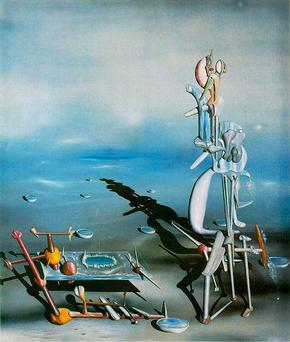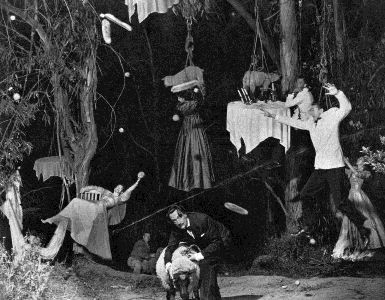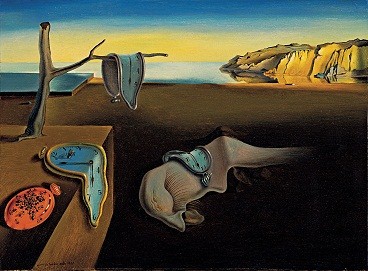Perhaps most notable by the works of Salvador Dali, surrealism is a cultural movement popularized in Paris during the early 1920s. Surrealism developed mostly from the Dada movement, and was firmly established by André Breton with his writing, Surrealist Manifesto. In this work, Breton described surrealism as “pure psychic automatism”. This phrase captures the freedom from rational control and expression of the subconscious which surrealism seeks to channel. Other attributes include philosophic explorations and the interplay between dream and reality.
Surrealism’s influence expands into works of literature, film, theatre, and music. These forms allow the artist to create works on the verge of the world of dreams and tap into the metaphysical experience. In music, surrealist themes can be found in jazz and blues improvisation and avant-garde styles.
Surrealist ideas still exist and have impacted many modern artistic movements. The main appeal of surrealism to artists seems to be the emphasis on liberation of the mind and the “imaginative powers of the subconscious”. Below, I have included examples of surrealist aesthetics across several mediums.
http://www.artinthepicture.com/styles/Surrealism/
http://www.theartstory.org/movement-surrealism.htm

Salvador Dali — “The Ship”

Yves Tanguy — “Indefinite Divisibility”

Jorge Luis Borges — “Dreamtigers” (interesting read)
https://www.youtube.com/watch?v=2uhaFhsI6Uk
Georges Melies — “Trip to the Moon”
Although this film predates the Surrealist movement, it illustrates some surrealistic characteristics.

Scene from a surrealist theatrical.
Miles Davis — “Bitches Brew” album (example of how avant-garde jazz accomplishes surrealistic aesthetics)


6 Comments. Leave new
Other than the classic Dali Persistence of Memory painting, I had never really payed much attention to the surrealism movement. Over Thanksgiving break, I happened to walk into a Vladimir Kush art gallery after peeking in the window. His artwork fascinated me, and made me feel like I was in the fantasy land of a child’s imagination. As I walked around, I noticed that many of his works shared similar themes and settings, and I had so many questions that I wanted to ask the painter. Aside from the bizarre nature and societal commentary of the content, the style itself is an interesting contrast of hyper realism in both detail and color, with cartoon images. You can check out some of his artwork online: https://www.google.com/search?q=Vladimir+Kush&source=lnms&tbm=isch&sa=X&ved=0ahUKEwjd-7XNocTKAhWLvIMKHUfeC_EQ_AUIBygB&biw=1920&bih=995https://www.google.com/search?q=Vladimir+Kush&source=lnms&tbm=isch&sa=X&ved=0ahUKEwjd-7XNocTKAhWLvIMKHUfeC_EQ_AUIBygB&biw=1920&bih=995 . I also thought A Trip to the Moon was awesome. The use of color and the unique soundtrack in the restored version creates an entirely new aesthetic in it self (here is the original https://www.youtube.com/watch?v=BNLZntSdyKEhttps://www.youtube.com/watch?v=BNLZntSdyKE ).
Other than the classic Dali Persistence of Memory painting, I had never really payed much attention to the surrealism movement. Over Thanksgiving break, I happened to walk into a Vladimir Kush art gallery after peeking in the window. His artwork fascinated me, and made me feel like I was in the fantasy land of a child’s imagination. As I walked around, I noticed that many of his works shared similar themes and settings, and I had so many questions that I wanted to ask the painter. Aside from the bizarre nature and societal commentary of the content, the style itself is an interesting contrast of hyper realism in both detail and color, with cartoon images. You can check out some of his artwork online: https://www.google.com/search?q=Vladimir+Kush&source=lnms&tbm=isch&sa=X&ved=0ahUKEwjd-7XNocTKAhWLvIMKHUfeC_EQ_AUIBygB&biw=1920&bih=995 . I also thought A Trip to the Moon was awesome. The use of color and the unique soundtrack in the restored version creates an entirely new aesthetic in it self (here is the original https://www.youtube.com/watch?v=BNLZntSdyKE ).
While Surrealism as we’ve defined it has distinguishing characteristics, I feel that it is really near to the pure motivation to depict the seemingly impossible in any form of art. If artists were to simply replicate their surroundings, their ability to capture the imagination of viewers would be severely limited. Some medieval Europeans depictions of what foreigners looked like prior to 1492 definitely captured peoples’ attention and could very well be classified as surrealism although the label was not yet coined.
Check out this link for more on that: http://www.inquisitr.com/2089001/are-these-medieval-pictures-proof-aliens-really-did-visit-the-earth-in-the-middle-ages/
It could be argued that surrealism as we know is not so much the product of true inspiration, but rather the low hanging visual fruit of individuals who partake in certain drugs. For an artist like Salvador Dali, who was an avid drug user, it may not have been much of a stretch of the imagination to see the clock melting.
I like that your examples pull in many genres of art that are all tied to surrealism. You mentioned that surrealism is still influential today – a great example to include would have been Burning Man, where for a few days each year participants get to live out surrealism.
A couple of years ago, I never accepted surrealism. I thought it was silly, partially because I didn’t understand it and did not like to think away from reality. But when I started reading about surrealism more I was really impressed by how much power this art form can deliver. It can replace a couple if pages of fiction in one image. I started accepting this art form and actually preferred it more than realism because of its ability to convey powerful ideas.
I really like that you included forms of art in your post other than just paintings. When I first saw the title, my first thought was that there would be only pictures of paintings shown – thanks for pointing out that it is not just limited to that medium.
Additionally, I’m very glad you included the video “A Trip to the Moon” – never seen that before.
Surrealism is one of my favorite art forms, the emotions evoked by the artists ,who seem liberated by the abandon of logic, are some of my most powerful reactions to art. In my hometown there is a museum dedicated primarily to Dali, the detail and skill within his surreal projects is simply fascinating. Every time I visit I can sit for hours looking at one painting constantly finding new levels and perspectives in the art piece. Surrealism’s ability to alter perspectives for people experiencing work done is one of my favorite aspects of this aesthetic .